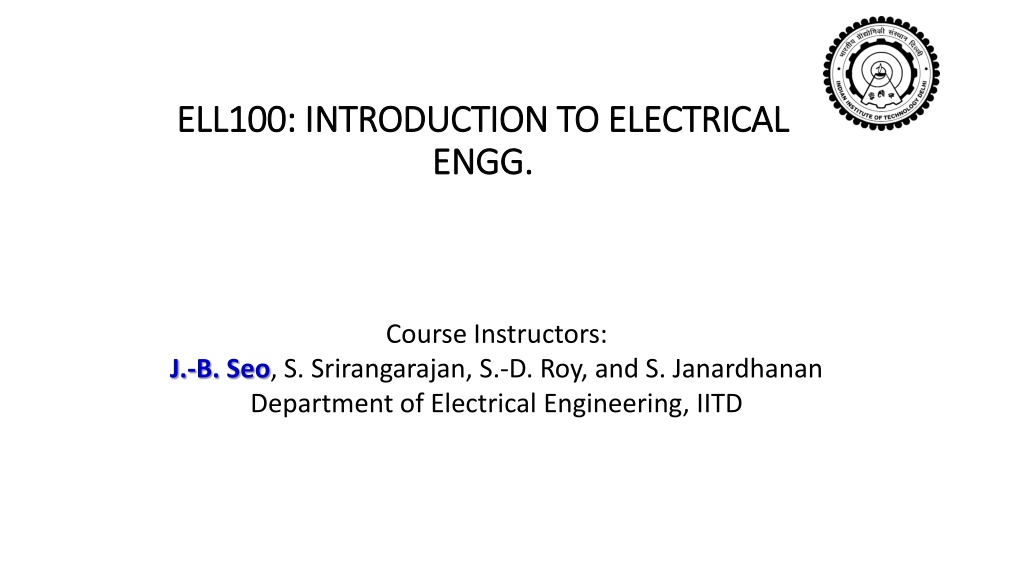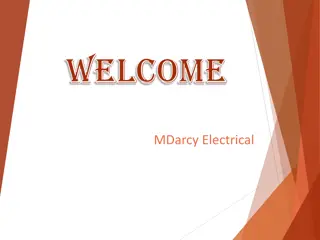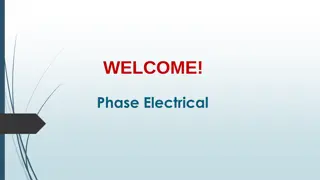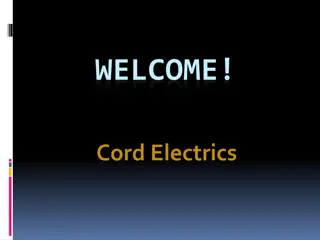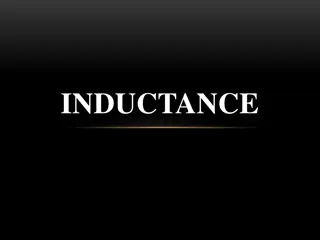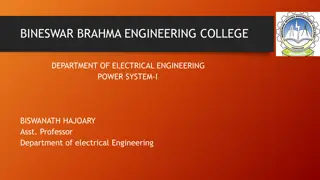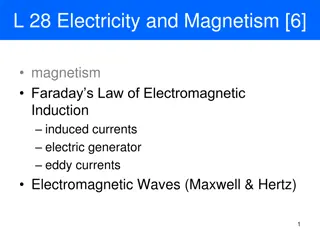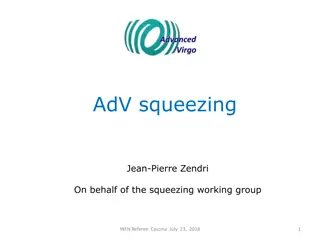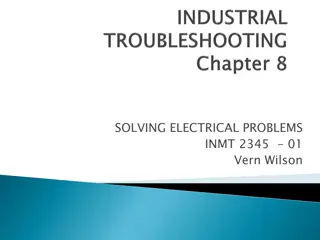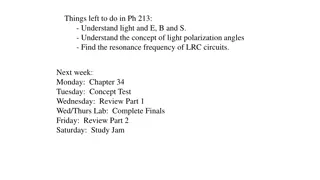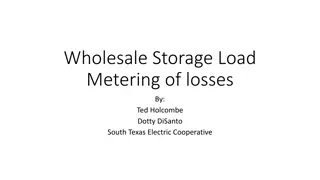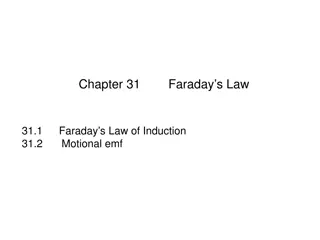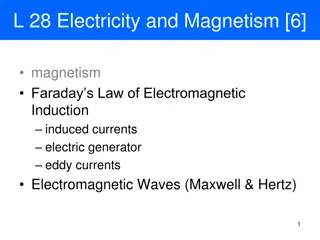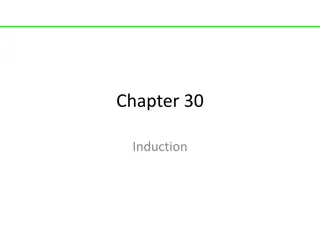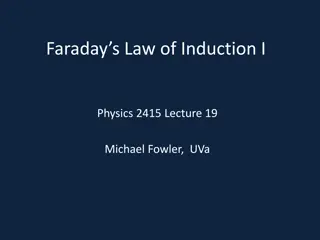Understanding AC Power Generation and Faraday's Law in Electrical Engineering
This course introduces students to AC power generation in electrical engineering. Concepts such as magnetic flux, induction of EMF through Faraday's Law, and examples like hydroelectric turbines and gasoline motors are covered. The course aims to provide a comprehensive understanding of how electrical energy is generated and harnessed efficiently.
Download Presentation

Please find below an Image/Link to download the presentation.
The content on the website is provided AS IS for your information and personal use only. It may not be sold, licensed, or shared on other websites without obtaining consent from the author. Download presentation by click this link. If you encounter any issues during the download, it is possible that the publisher has removed the file from their server.
E N D
Presentation Transcript
ELL100: INTRODUCTION TO ELECTRICAL ELL100: INTRODUCTION TO ELECTRICAL ENGG. ENGG. Course Instructors: J.-B. Seo, S. Srirangarajan, S.-D. Roy, and S. Janardhanan Department of Electrical Engineering, IITD
AC power generation AC power generation Magnetic flux Magnetic flux density Flux depends on orientation of surface with respect to B field.
AC power generation AC power generation Induced emf (electro-magnetic force) in a closed loop equals negative of time rate of change of magnetic flux through the loop (Faraday s Law)
AC power generation AC power generation Induced emf (electro-magnetic force) in a closed loop equals negative of time rate of change of magnetic flux through the loop (Faraday s Law) Assume that Water turning a turbine (hydroelectric) N S Gasoline Motor turning a shaft (AC generator) Note that for
AC power generation AC power generation Induced emf (electro-magnetic force) in a closed loop equals negative of time rate of change of magnetic flux through the loop (Faraday s Law) Assume that Water turning a turbine (hydroelectric) N S Gasoline Motor turning a shaft (AC generator) Note that for
AC power generation AC power generation Induced emf (electro-magnetic force) in a closed loop equals negative of time rate of change of magnetic flux through the loop (Faraday s Law) Assume that Water turning a turbine (hydroelectric) N S Gasoline Motor turning a shaft (AC generator) Note that for
AC power generation AC power generation N S
Generating three Generating three- -phase voltage phase voltage
Generating three Generating three- -phase voltage phase voltage Single-phase voltage Three-phase voltage can be also generated with three single-phase voltage Load
Generating three Generating three- -phase voltage phase voltage Single-phase voltage Three-phase voltage can be also generated with three single-phase voltage This can be combined as a single neutral line Load
Two methods of source connections Two methods of source connections voltages between the lines a,b,c and the neutral line n: phase voltages. voltages between the lines Vab, Vbc, Vca: phase voltages.
Two methods of source connections Two methods of source connections
Phase sequence Phase sequence Balanced phase voltages are equal in magnitude and are out of phase with each other by 120. There are two possible ways in which a source can be balanced Positive or abc sequence Negative or acb sequence
Phase sequence Phase sequence Balanced phase voltages are equal in magnitude and are out of phase with each other by 120. There are two possible ways in which a source can be balanced Positive or abc sequence Negative or acb sequence
Balanced three phase load Balanced three phase load Similar to the source, the load can also be Delta or Wye connected. A balanced load: the phase impedances are equal in magnitude and in phase.
Connections with loads Connections with loads
Balanced Wye Balanced Wye- -Wye Connection Wye Connection 1 1 Balanced load: Line voltage (or line-to-line voltage)
Balanced Wye Balanced Wye- -Wye Connection Wye Connection 1 1 Balanced load: Line voltage (or line-to-line voltage)
Balanced Wye Balanced Wye- -Wye Connection Wye Connection 1 1 Balanced load: Line voltage (or line-to-line voltage)
Balanced Wye Balanced Wye- -Wye Connection Wye Connection 2 2 By KVL, the current along the line (line current): Voltage across neutral line is zero: it can be removed Phase current is the current in each phase of the source of load. In Y-Y system, the line current is the same as the phase current.
Balanced Wye Balanced Wye- -Wye Connection Wye Connection 2 2 By KVL, the current along the line (line current): Voltage across neutral line is zero: it can be removed Phase current is the current in each phase of the source of load. In Y-Y system, the line current is the same as the phase current.
Example of Y Example of Y- -Y system Y system Neutral line
Balanced Wye Balanced Wye- -Delta Connection Delta Connection 1 1 Phase voltage Line voltage is Phase current can be Alternatively,
Balanced Wye Balanced Wye- -Delta Connection Delta Connection 1 1 Phase voltage Line voltage is Phase current can be Alternatively,
Balanced Wye Balanced Wye- -Delta Connection Delta Connection 2 2 Line currents are obtained by KCL Magnitude of line currents:
Example Example A balanced abc-sequence Y-connected source with is connected to a Delta-connected balanced load per phase. Calculate the phase and line currents. and Using we have The phase current is The line current
Balanced Delta Balanced Delta- -Delta Connection Delta Connection Assuming a positive sequence, the phase voltages for a delta-connected source are The line voltages are the same as the phase voltage The phase currents The line currents are obtained from the phase currents by applying KCL at nodes A, B, and C
Balanced Delta Balanced Delta- -Delta Connection Delta Connection Assuming a positive sequence, the phase voltages for a delta-connected source are The line voltages are the same as the phase voltage The phase currents The line currents are obtained from the phase currents by applying KCL at nodes A, B, and C
Example Example A balanced -connected load having an impedance is connected to a -connected, positive-sequence generator having . Calculate the phase currents of the load and the line currents.
Balanced Delta Balanced Delta- -Wye Connection Wye Connection Assuming the abc sequence, the phase voltages of a delta-connected source are These are also the line voltages as well as the phase voltages. In order to get the line current, apply KVL to loop aANBba,
Balanced Delta Balanced Delta- -Wye Connection Wye Connection In order to get the line current, apply KVL to loop aANBba, Since we assume the abc sequence, The phase currents are equal to the line currents.
Delta Delta- -Wye Transformation Wye Transformation Another possible way to analyze the Delta-Star connection. Transform Delta connected source to Star connected source Analyze the Y-Y connection. Observing the phase voltage to line voltage relation in the Y-Y connection
Example Example A balanced Y-connected load with a phase impedance of is supplied by a balanced, positive sequence -connected source with a line voltage of 210 V. Calculate the phase currents. Use as a reference .
Power in a Balanced system Power in a Balanced system For a Y-connected load, the phase voltages are the phase currents lag behind their corresponding phase voltages by The total instantaneous power in the load is the sum of the instantaneous powers in the three phases
Power in a Balanced system Power in a Balanced system Applying the trigonometric identity, Thus the total instantaneous power in a balanced three-phase system is constant it does not change with time as the instantaneous power of each phase does.
Power in a Balanced system Power in a Balanced system The average power per phase for either the -connected load or the Y-connected load is p/3, or The reactive power per phase The apparent power per phase The complex power per phase
Power in a Balanced system Power in a Balanced system The total average power is the sum of the average powers in the phases The total reactive power The total complex power
Advantage of three Advantage of three- -phase circuit phase circuit Consider an amount of power PL being transmitted at the same line voltage VL using Single phase supply 3-phase balanced supply Power dissipation in transmission
Advantage of three Advantage of three- -phase circuit phase circuit Power dissipation in transmission If same amount of power loss is to be allowed Ratio of material required for transmission wires In other words, a 3-phase supply can deliver power, and follow power loss constraints using only 75% of the material as an equivalent single phase supply.
